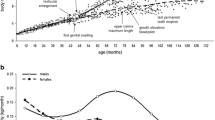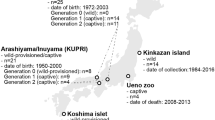Abstract
I analyzed somatometric measurements from subsets of the Texas and Oregon transplanted troops of Japanese macaques(Macaca fuscata) to reveal secular changes in body size and shape. Body weights of the Texas population (N = 59) are lower than those of the Oregon population(N = 49) and the founding population from Arashiyama. The adult weights of the Oregon population are significantly higher than the founding population from Mihara. There are significant differences in adult circumferential measures and in skinfolds, which are correlated with the increased weight of the Oregon macaques. The adult Texas macaques have longer limb segments in comparison with the adult Oregon troop members, while the latter have significantly longer heads and trunks. Examination of the developing morphological trends through regression analyses on the complete sample suggests distinctive growth patterns for each population. Members of the Texas population start with smaller initial measurements but hold a steeper growth pattern for limb segments, while the Oregon macaques start larger in most measures and show lower growth rates. I argue that these differences in both somatometry and growth patterns are related to the differing climatic conditions under which the translocated macaques have lived. This set of analyses supports the basic arguments for Bergmann’s rule and Allen’s rule.
Similar content being viewed by others
References
Altmann, J., and Alberts, S. (1987). Body mass and growth rates in a wild primate population.Oecologia 72: 15–20.
Altmann, J., Schoeller, D., Altmann, S. A., Muruthi, P., and Sapolsky, R. M. (1993). Body size and fatness of free-living baboons reflect food availability and activity levels.Am. J. Primatol 30: 149–161.
Allen, J. A. (1877). The influence of physical conditions in the genesis of species.Radical Rev. 1: 108–140.
Bergmann, C. (1847).Ueber die VemhÄltnisse der WÄrmeökonomie der Tiere zu ihrer Grosse, Göttinger Studien, pp. 595–708.
Bramblett, C. A. (1994).Patterns of Primate Behavior, 2nd ed., Waveland Press, Prospect Heights.
Brody, S. (1945).Bioenergetics and Growth: With Special Reference to the Efficiency Complex in Domestic Animals, Reinhold, New York (Reprinted 1964, Hafner, New York).
Dahl, J. F., and Smith, E. O. (1982). Thermoregulatory, microhabitat preferences of stumptail macaques.Am. J. Phys. Anthropol. 57(2): 179 (abstr.).
Dahl, J. F., Bernstein, I. S., and Williams, L. (1986). Thermoregulation and social structure of a captive group of rhesus macaques. In Taub, D., and King, F. (eds.),Current Perspectives in Primate Social Dynamics, Van Nostrand, New York.
Degabriele, R., and Dawson, T. J. (1979). Metabolism and heat balance in an arboreal marsupial, the koala(Phascolarctos cinereus).J. Comp. Physiol. 34: 293–301.
Eaton, G. G., Rostal, D. C., Glick, B. B., and Senner, J. W. (1987). Seasonal behavior in a confined troop of Japanese macaques(Macaca fuscata).Prog. Biometeorol. 5: 29–40.
Dunbar, R. I. M. (1988).Primate Social Systems, Croom Helm, Beckenham.
Fedigan, L. (1991). Life span and reproduction in Japanese macaque females. In Fedigan, L. M., and Asquith, P. J. (eds.),The Monkeys of Arashiyama: Thirty-Five Years of Research in Japan and the West, State University of New York Press, Albany, pp. 140–154.
Fedigan, L. M., and Asquith, P. J. (eds.) (1991).The Monkeys of Arashiyama: Thirty-Five Years of Research in Japan and the West, State University of New York Press, Albany.
Frisancho, A. R. (1979).Human Adaptation: A Functional Interpretation, C. V. Mosby, St. Louis.
Gale Research Company (1985).Climates of the States. NOAA Summaries, Vol. 2, Book Tower, Detroit.
Gallilei, G. (1637).Dialogues Concerning Two New Sciences (H. Crew and A. De Salvio, trans., 1914), Macmillan, New York.
Geist, V. (1987). Bergmann’s rule is invalid.Can. J. Zool. 65: 1035–1038.
Geist, V. (1990). Bergmann’s rule is invalid: A reply to J. D. Paterson.Can. J. Zool. 68: 1613–1615.
Gouzoules, H., Gouzoules, S., and Fedigan, L. M. (1981). Japanese monkey group translocation: Effects on seasonal breeding.Int. J. Primatol. 2: 323–334.
Graves, G. R. (1991). Bergmann’s rule near the equator: Latitudinal clines in body size of an Andean passerine bird.Proc. Natl. Acad. Sci. USA 88: 2322–2325.
Hori, T., Tokura, H., and Tadaki, E. (1972). Surface area in the Japanese monkey, Macaca fuscata.J. Appl. Physiol. 32(3): 409–410.
Hori, T., Nakayama, T., Tokura, H., Hara, F., and Suzuki, M. (1977). Thermoregulation of the Japanese macaque in a snowy mountain area.Japan. J. Physiol. 27: 305–319.
Huxley, J. (1932).Problems of Relative Growth, Methuen, London.
James, F. C. (1970). Geographic size variation in birds and its relationship to climate.Ecology 51: 365–390.
Kleiber, M. (1961).The Fire of Life: An Introduction to Animal Energetics, Wiley and Sons, New York.
Mano, T., Norikoshi, K., and Koyama, N. (1972). Report on tattoo numbers, names, and body weight of Japanese monkeys at Arashiyama (A troop).J. Anthropol. Soc. Nippon 80(4): 381–383.
McNab, B. K. (1970). Body weight and the energetics of temperature regulation.J. Exp. Biol. 53: 329–348.
McNab, B. K. (1971). On the ecological significance of Bergmann’s rule.Ecology 52(5): 845–854.
Meeh, K. (1879). OberflÄchenmessungen des menschichen Körpers.Z. Biol. 15: 425–458.
Molnar, S. (1992).Human Variation: Races, Types and Ethnic Groups, Prentice Hall, Englewood Cliffs, NJ.
Mori, A. (1979). Analysis of population changes by measurement of body weight in the Koshima troop of Japanese monkeys.Primates 20(3): 371–398.
Murphy, E. C. (1985). Bergmann’s rule, seasonality, and geographic variation in body size of house sparrows.Evolution 39: 1327–1334.
Negayama, K., Ando, A., Hara, A., Kamada, J., Kondo-Ikemura, K., Koyama, T., Nakamichi, M., and Yoshida, A. (1988). Basic behavioral profiles among adults of the Arashiyama A troop and the Arashiyama B troop.Research Reports of the Arashiyama West and East Groups of Japanese Monkeys, Laboratory of Ethological Studies, Osaka, pp. 1–18.
Paterson, J. D. (1982). Thermoregulatory behaviour and ecological factors in primates.Can. Rev. Phys. Anthropol 3: 3–11.
Paterson, J. D. (1986). Shape as a factor in primate thermoregulation. In Taub, D. M., and King, F. A. (eds.),Current Perspectives in Primate Social Dynamics, Van Nostrand, New York, pp. 228–242.
Paterson, J. D. (1990). Bergmann’s rule is invalid—A reply to V. Geist.Can. J. Zool. 68: 1610–1612.
Paterson, J. D. (1992). An alternative view: Behaviour as a multi-causal strategy for survival. In Burton, F. D. (ed.),Social Processes and Mental Abilities in Non-Human Primates, Evidence from Longitudinal Field Studies, Edwin Meilen Press, Lewiston, NY, pp. 129–181.
Paterson, J. D. (1994). Behavioural thermoregulation and structural adaptation in the Arashiyama “A” troop. In Anderson, J. R., Roeder, J. J., Thierry, B., and Herrenschmidt, N. (eds.),Current Primatology, Vol. III. Behavioural Neuroscience, Physiology and Reproduction. Selected Proceedings of the 14th Congress of the International Primatological Society, Université Louis Pasteur, Strasbourg, pp. 227–236.
Peters, R. H. (1983).The Ecological Implications of Body Size, Cambridge University Press, Cambridge.
Porter, W. P., and Gates, D. M. (1969). Thermodynamic equilibria of animals with environment.Ecol. Monogr. 39: 227–244.
Rahbek, C. (1996). Bergmann’s rule in some species of Andean birds.J. Avian Biol. (in press).
Rostal, D. C., and Eaton, G. G. (1983). Puberty in male Japanese macaques(Macaca fuscata): Social and sexual behavior in a confined troop.Am. J. Primatol. 4: 135–141.
Rudloff, W. (1981).World Climates: With Tables of Climatic Data, Wissenschaftliche Verlagsgesellschaft mbH, Stuttgart.
Sarrus and Rameaux (1838–1839). Rapport sur un mémoire adressé a l’Académie Royale de Médecine. Commissaires Robiquet et Thillaye, rapporteurs.Bull. Acad. Roy. Méd. (Paris) 3: 1094–1100.
Schmidt-Nielsen, K. (1984).Scaling: Why is Animal Size So Important, Cambridge University Press, Cambridge.
Schneiderman, E. D., Willis, S. M., Kowalski, C. J., and Ten-Have, T. R. (1992). A PC program for growth prediction in the context of Rao’s polynomial growth curve model.Comput. Biol. Med. 22(3): 181–188.
Schollader, P. F., Hock, R., Walters, V., Johnson, F., and Irving, L. (1950). Heat regulation in some arctic and tropical mammals and birds.Biol. Bull. 99: 237–258.
Searcy, W. A. (1980) Optimum body sizes at different ambient temperatures: An energetics explanation of Bergmann’s rule.J. Theor. Biol. 83: 579–593.
Sugiyama, Y., and Ohsawa, H. (1982). Population dynamics of Japanese monkeys with special reference to the effect of artificial feeding.Folia Primatol 39: 238–263.
Author information
Authors and Affiliations
Rights and permissions
About this article
Cite this article
Paterson, J.D. Coming to America: Acclimation in macaque body structures and Bergmann’s rule. Int J Primatol 17, 585–611 (1996). https://doi.org/10.1007/BF02735193
Received:
Revised:
Accepted:
Issue Date:
DOI: https://doi.org/10.1007/BF02735193




